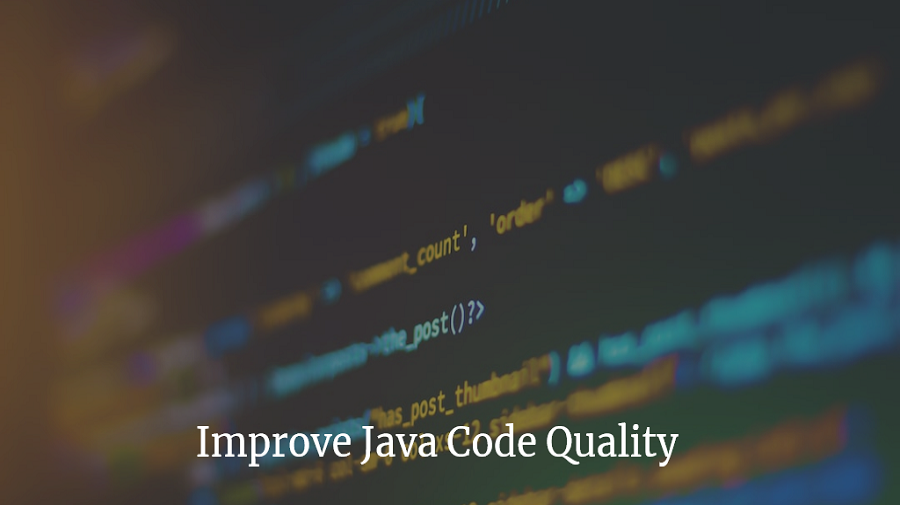7 Best Practices To Improve the Java Code Quality

Best practices are a type of informal mandate that the majority of software developers follow for improving code readability, software quality, and maintainability. These informal rules are beneficial when an app will remain in use for a long time, and subsequently, a group of people will develop and use that app.
Along with improving the software quality, improving the code quality is also important for building an effortlessly working app. When any errors are left unaddressed, it will cause problems. Hence, following best practices suggests that whenever any error is encountered, solve it first.
Java programming language is one of the well-known names in the world of software development. Even in Java, there are certain best practices to follow for writing clean and readable code.
Here, we will discuss best practices for improvisation of Java code quality. So, let’s dive in!
Why is it important to improve the Java code quality?
————————————–
Clean code in Java means writing readable, straightforward, easy-to-understand, and testable code. Other functions of clean code include adherence to best conventions and other best practices to promote conciseness, expressiveness, and maintainability.
Code that is free from errors, complexity, redundant code, and similar things is called a clean code.
Uncle Bob- Robert C. Martin has written many informative things on clean code and its benefits. Programmers who want to write clear code can read his book and articles on clean code. Here’s a quote from that book:
“Even bad code can function. But if code isn’t clean, it can bring a development organization to its knees. Every year, countless hours and significant resources are lost because of poorly written code. But it doesn’t have to be that way ” taken from Clean Code: A Handbook of Agile Software Craftsmanship.
Here are some benefits of improving the Java code quality:
- Debugging- Clean code has fewer chances of errors. It is easier to separate and fix errors in such code
- Easy to fix and update written code
- Clean code is reusable, modular, and accommodative for future changes
- When developers write clean code, such codes are self-explanatory and minimize the need for extra and complex comments
- Java clean code is always easy to read, minimizes confusion, and enhances maintainability
- When a clean code is written, it improves the efficiency of the code by removing unnecessary complexity, and code duplication.
Now let’s begin with learning the top 7 best practices for writing clean code in Java and improving the code quality.
7 Best Practices to Improve Your Java Code Quality
————————————–
Java language is still a popular choice amongst developers. As it’s a well-established language, Java is still important to run critical business infrastructure and software developed in a decade and is still being used by many users.
Because of the longevity feature of the Java codebase, it is essential to improve the Java coding quality. It will also be useful for future developers to work on code that was written in the past. So, let’s discuss the Java best practices to write clean code:
1# Start Using Automated Tests
Automated testing is a way to find bugs earlier and avoid them from becoming bigger problems. Automated tests ensure that updates made in the code don’t interrupt existing functions, and provide confidence in updating the codebase.
Here are the benefits of building automated tests:
- Lower manual testing efforts: When you replace manual testing with automated testing, it can save a lot of time and resources for you
- Easy and early error detection: With automated testing, you can catch bugs in the early phase itself and it saves a lot of time and effort in the long run, and also improves overall code quality, If bugs are caught in a later phase, they might have already become a huge trouble
- Enhanced efficiency and speed: Automated tests run efficiently and quickly making it easier to catch errors and verify that your code is working as per the expectations
- Better confidence while updating the code: When you have automated tests in place, you can confidently update the code without worrying about the automated tests harming the normal functioning of your code
When you write tests, covering different necessary situations and use cases is important. It ensures that the code is necessarily tested, and errors are found earlier. It is also an amazing idea to write tests before writing code, as it can help you to clarify the needs and ensure that the code is written to complete those requirements.
2# Following proper naming conventions
It can be an amazing choice if you intend to handle the standard naming convention for the code, and you should do this before you make a line of code.
For example, naming standards can deal with things like accurate naming of constants, variables, classes, methods, and interfaces among other things.
While you name identifiers such as classes, methods, and variables, it’s necessary to do so in a self-explanatory, distinct, and easy manner.
Most necessarily, you have to ensure to build readable code that’s easy to understand by humans and is not just made for compilers. It’s a standard Java practice used by many developers.
3# Using version control
VCs or Version Control helps in tracking the changes in code happening over time. It makes it simpler to revert to the first versions when necessary. This tool also helps different developers to work on the same code at the same time without creating conflicts.
The advantages of version control are:
- VC helps in tracking the updates made in the code to make it simpler to go back to the previous versions when required. It can be useful in case of errors or other bugs in the code
- It makes a backup of the codebase that helps in recovering the previous code in case of mistakes or accidents
- Multiple programmers can work on the same codebase simultaneously without creating disputes between them
- Provides transparency to the developers while working on the same codebase
Different VCs are available, and Git is one of the strongest version control systems.
While using VC, it’s required to follow some best practices like using branches, building descriptive commit messages and merging updates in the primary code.
4# Use underscore in numeric literals
Developers can build big numeric literals that have excellent readability. Thanks to the Java 7 update.
Here’s an example of using Underscore:
float pi = 3.141592653589F;
long debit balance = 5000000000000000 L;
int minUploadSize = 05437326;
Here’s an instance after making use of Underscore:
float pi = 3.141_592_653_589F;
long debit balance = 5_000_000_000_000_000L;
int minUploadSize = 05_437_326;
The above-mentioned Java declarations will show the value of using underscores in the different numeric literals to make the code easier to read. This statement that has an underscore is more easily readable than other statements. It became a standard coding practice after Java version 7.
5# Easy collaboration with multiple developers
Easy collaboration with multiple developers is an important step in enhancing the Java code quality. Collaboration gets different perspectives in the project development process, helps to avoid strong errors, and improves the whole code quality.
An essential step is to collaborate with different developers to improve the code quality. Collaboration brings different perspectives of the development process that help to search for potential issues and improve the whole code quality. This step is particularly important to create marketing assets that help in the customer journey as collab ensures applications are integrated easily with different assets and websites. It also provides seamless & high-quality UX.
Here are some advantages of collaborating with other developers:
- Better codebase quality. When there are various perspectives in the development process, it helps to solve different issues and improves the code quality.
- Improved knowledge sharing. When multiple developers are involved, and they start following relevant best practices, they can share their knowledge with others as well.
- Minimized risk of bugs. Multiple developers, when working on the same project, can have multiple eyes on the bugs. So, it gets easy to search for bugs and solve them.
- Better code reviewing. Different developers working together can enhance the process of code review.
These are some of the main advantages of having multiple skilled programmers working on the same project.
6# Using a Linter
Linter is a whole program that verifies syntax errors, possible bugs, and style violations. While using this program, developers can quickly identify the problem in the code, and make required improvements.
The advantages of using a linter are:
- Consistent styling of code- Helps to maintain a consistent coding style, making code easier to manage and read.
- Better code quality- Helps to hold the potential issues in writing code, reducing the risk of the bug and improving the whole code quality.
- Better productivity- Make the whole development process efficient by quickly identifying potential risks in advancements.
- Minimized errors- Helps in minimizing the errors in the code to improve the whole code.
While the linter program is being used, it is necessary to keep these things in mind:
- Pick a linter that’s appropriate for the languages
- Customize the program as per the requirements
- Use the linter in the development process of your software
- By identifying the potential issues of the code, the linter helps with the easy maintenance of high-quality coding.
7# Refactoring the code regularly
Refactoring means changing the whole code structure without updating its behavior. It involves rewriting the parts of the coding to make it readable, manageable, and efficient. Here are the main advantages of code refactoring:
- Better readability- Makes the code more straightforward and readable for other programmers to maintain and understand the code
- Better efficiency- Makes the whole code efficient, reducing the resources needed to run it
- Decreased risk of errors- Improves the whole reliability of the code
- Better maintainability- makes the whole code maintainable, minimizes the time, and efforts to change the code
Here are some factors that are necessary to keep in mind while refactoring code:
- Make small and incremental changes- Making small changes is important when refactoring the code, as important changes make the bugs catching problematic. Little updates make it simple to update the previous versions whenever necessary.
- Write automated tests- Before any refactoring is done in the code, it is important to write automated tests to make sure that your code is working well. This helps to catch any bugs introduced while the refactoring process is being done.
Concluding words
These 7 best practices can improve the overall Java code quality. If you want to learn more about the practices, you can stay tuned with us. Happy learning!




